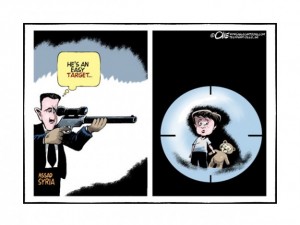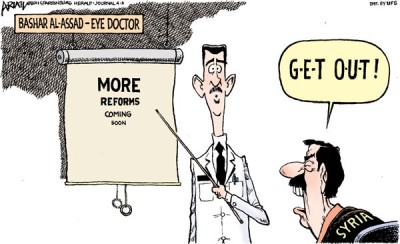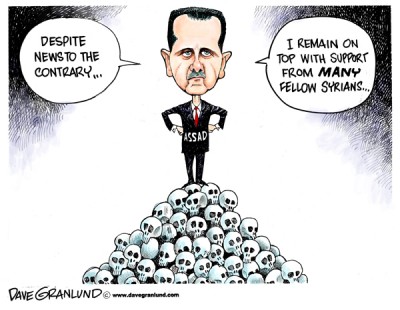 BEIRUT, Lebanon – President Bashar al-Assad of Syria said on Wednesday that his government’s battle against opposition forces would need “time” and that a proposal floated by Syria’s opponents to create buffer zones inside the country was unrealistic.
BEIRUT, Lebanon – President Bashar al-Assad of Syria said on Wednesday that his government’s battle against opposition forces would need “time” and that a proposal floated by Syria’s opponents to create buffer zones inside the country was unrealistic.
In excerpts from an interview with Mr. Assad that will air on a private Syrian channel on Thursday night, the president framed the conflict and Syria as a “global and regional war,” praised the heroism of his army and criticized officials in neighboring Turkey, who have raised the possibility of military intervention in Syria.
“Will we go backward, because of the ignorance of some Turkish officials?” he said.
“We are moving forward,” Mr. Assad added. “The situation, practically, is better.”
In the excerpts, the president also addressed persistent rumors that he had gone into hiding, perhaps somewhere outside Syria’s capital, saying he was in the presidential palace in Damascus. Mr. Assad last appeared on television 10 days ago, when he visited a Damascus mosque during the Id al-Fitr holiday.
The interview comes after days of fierce fighting in the capital’s suburbs, including in the city of Daraya, where hundreds of people were said to have been killed over the last week as the army tried to rout armed opposition fighters who made a base in the city. Opposition activists said that at 11 people had been killed in fighting in the eastern suburbs of Damascus on Wednesday, where the government has said it is pursuing “cleansing” operations.
 In an article published on Wednesday in the British daily The Independent, residents of Daraya raised the possibility that opposition fighters were behind some of the killings last week. One woman said in the article that she saw at least 10 bodies on the road, before government troops had entered Daraya. Another man said that some victims, including civil employees and off-duty conscripts, might have been killed because of their association with the government.
In an article published on Wednesday in the British daily The Independent, residents of Daraya raised the possibility that opposition fighters were behind some of the killings last week. One woman said in the article that she saw at least 10 bodies on the road, before government troops had entered Daraya. Another man said that some victims, including civil employees and off-duty conscripts, might have been killed because of their association with the government.
In a further sign of the intensity of the conflict, the United Nations refugee agency said on Tuesday that the number of Syrian refugees fleeing to Jordan last week had more than doubled from the previous week, raising further fears of a growing exodus from Syria that threatens to overwhelm international relief efforts.
Speaking to reporters in Geneva, Melissa Fleming, the chief spokeswoman for the refugee agency, said that 10,200 Syrians had crossed into northern Jordan between Aug. 21 and Aug. 27, compared with 4,500 the week before. The refugees, she said, included an increasing number of unaccompanied children, some orphans and others sent ahead by parents, sometimes without passports.
 “Refugees say many thousands more are waiting to cross amid violence around Dara’a,” Ms. Fleming said, referring to the southern Syrian province that borders Jordan. “We believe this could be the start of a much larger influx. Some of those who have crossed in recent days — especially Friday — report being bombed by aircraft. There are also reports of shelling, mortars and other weapons fire.”
“Refugees say many thousands more are waiting to cross amid violence around Dara’a,” Ms. Fleming said, referring to the southern Syrian province that borders Jordan. “We believe this could be the start of a much larger influx. Some of those who have crossed in recent days — especially Friday — report being bombed by aircraft. There are also reports of shelling, mortars and other weapons fire.”
The waves of refugees fleeing Dara’a, the Damascus suburbs, Aleppo and the Idlib region near Turkey in recent days have provided a barometer of the escalating violence in the 18-month-old conflict, in which neither the government of President Bashar al-Assad nor the opposition seems capable of striking a decisive blow.
Ms. Fleming said the number of refugees escaping to Turkey had multiplied to 5,000 a day from 400 or 500 daily several weeks ago. In the past 24 hours, she said, 3,000 people had entered Turkey, with 10,000 more waiting.
In Turkey, which had said it would not accept more than 100,000 refugees, officials said they had revised the number to 120,000, and were preparing contingency plans for more.
Elsewhere around Damascus, at least 12 people were killed when a booby-trapped taxi exploded during a funeral procession in the suburb of Jaramana, in what the state news media called a “terrorist bombing.” An Associated Press reporter at the scene saw damaged buildings and shattered windows, and interviewed a woman who said her 6-year-old daughter had been killed.
In Idlib Province at least 23 people were killed after warplanes bombed the city of Kafr Nabl, according to activists and a local opposition commander, who said that one bomb had hit a market and that the dead were mostly civilians.
“The planes used to attack the outskirts, but today they changed their habit and attacked the center,” the commander said.
The death toll could not be corroborated, but at least five wounded people can be seen in a five-minute video that purports to show the aftermath of one bombing. It seems to have been filmed soon after an airstrike, opening with panicked scenes of cars and shops on fire, a rubble-strewn street and buildings pulverized by an explosion.
A man stumbles by the camera, clutching his left ear. “Oh, God!” someone wails, as the camera turns to a man, caked in blood, on a truck bed. Two other victims are carried past the camera: one has a large wound in the right thigh, and the other appears to be dead. Past a large, round crater in the ground, another victim is rolled onto a blanket and a second is dragged by his shirt.
Citing the failure of Syria’s fractured opposition movement to stem the bloodshed, a Syrian dissident, Bassma Kodmani, announced her resignation on Tuesday from the Syrian National Council, the main exile opposition group.
Since its creation, the council has been plagued by squabbles and criticized as a front for exiled dissidents — and principally, the Muslim Brotherhood — with little support inside Syria.
Ms. Kodmani, who was a member of the council’s executive committee and one of its most prominent faces, alluded to those criticisms in a statement on Tuesday, saying that the council had not maintained “the required credibility” and “veered from the path we set for it.”
She said that she would continue her opposition work from outside the council.
Her comments came as a group of Syrian dissidents presented a report in Berlin that they said was intended as a road map for a democratic transition to power after the fall of President Assad. The report, called the “The Day After Project,” was drafted by 45 Syrian activists who said they represented a broad spectrum of political and religious organizations.
Their meetings, held over the last year and a half, were initiated by the United States Institute of Peace, an independent but Congressionally financed organization, and the German Institute for International and Security Affairs in Berlin.
NY Times

Leave a Reply
You must be logged in to post a comment.